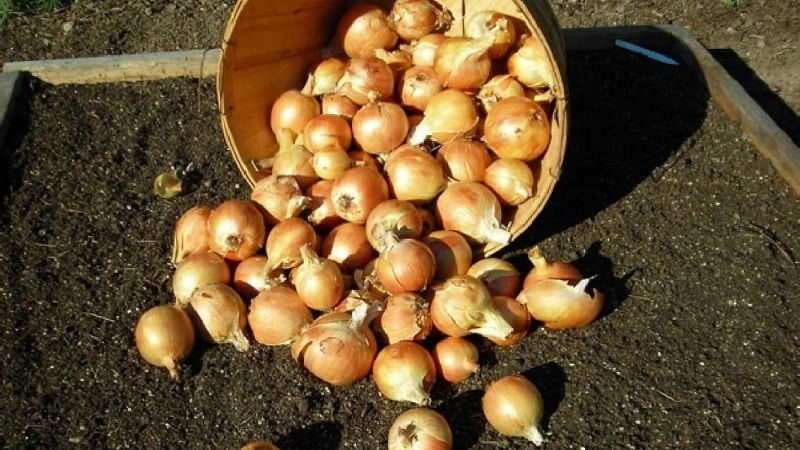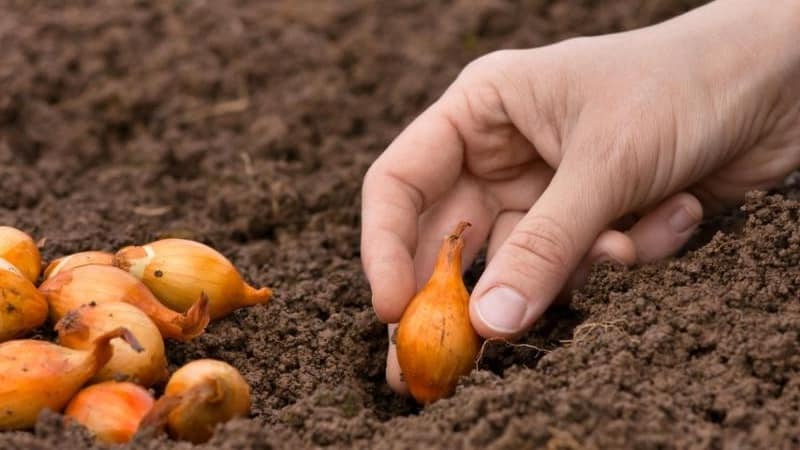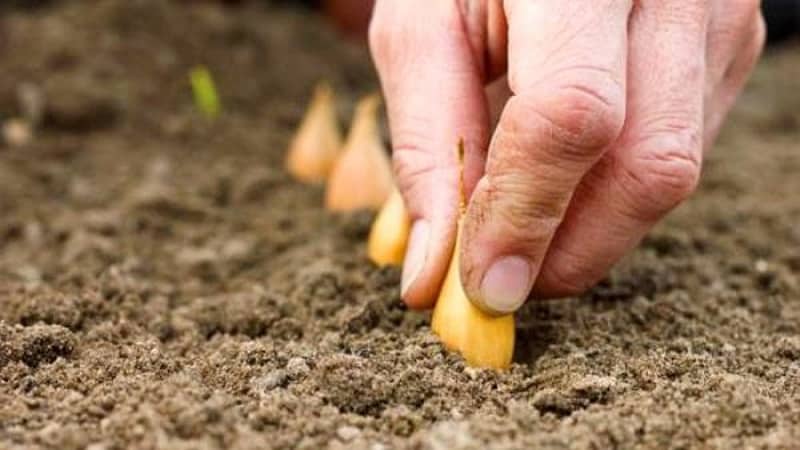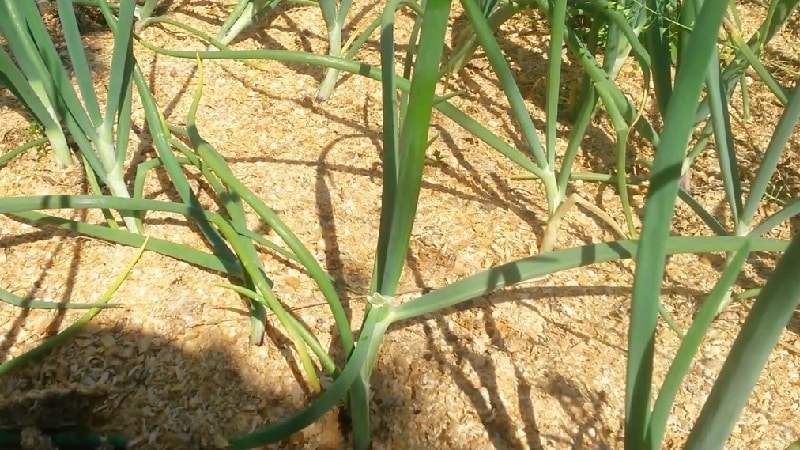Technology for planting onions before winter: at what depth and distance from each other to plant
Due to its numerous beneficial properties, unique aroma and taste, onions are popular among owners of vegetable gardens and summer cottages. It is planted not only in spring, but also before winter. This planting method has its own characteristics and advantages.
Advantages and disadvantages of planting onions before winter
The main advantage of this planting method is the opportunity to get early greenery for next year. The harvest is harvested almost a month earlier than with spring planting.

Wild oat grass is used as seed material - bulbs less than 1 cm in diameter. Such a set is cheap, does not go to waste and grows into a full-fledged turnip, which is well stored.
It should also be noted other advantages of planting winter onions:
- The natural conditions of winter harden the plants, so they become more resilient and rarely get sick.
- Due to the early emergence of seedlings in spring, the crop is less affected by pests. During this period, many insects are still absent.
- Onions are not overgrown with weeds as quickly as they develop faster.
- In early spring, there is a large amount of moisture in the soil, which is needed for full-fledged bulbs to form.
This method also has disadvantages. One of them is the inability to plant large seed material (more than 2 cm). It is not possible to get a turnip from it, since the bow goes into the arrow. Therefore, large bulbs can only be used for growing greens.
Other disadvantages:
- Lower germination rate.
- Difficulty in determining the optimal time for planting seed material due to differences in climatic conditions. Bulbs that do not have time to take root die in frost.
Winter onion varieties
More suitable for winter planting yellow and red varieties. Planting material is selected taking into account the weather conditions in which it will grow.
Most popular among gardeners:
- Black Prince. Mid-season variety. It has dark purple flesh and a semi-sharp taste.
- Robin. Suitable for growing in southern regions. The bulbs are red. They give a good harvest and easily tolerate drought.
- Lugansk. Ripens late. The flat bulbs have a pungent taste.
- Buran. A medium-yielding variety with yellow-brown turnips. Suitable for different climate zones.
- Radar. Dutch variety with high resistance to diseases and pests. Produces large bulbs weighing 200-300 g.

Choosing a landing site
Choose an area that is well lit and protected from the wind. If you plant the seedlings in a shaded place, the plants will rapidly grow green mass, and the formation of bulbs will be delayed.
Attention! It is important to choose a bed where water does not stagnate. If the soil is waterlogged, the bulbs will become wet and rot.
Preparation of planting material
For planting before winter, take a seed about 1-2 cm in size.. To obtain early greens, larger seed material is used.
Important! Only healthy seeds without damage or signs of disease are selected.
For two weeks Before planting, the sets are placed in water at a temperature of about 50°C for 2-3 hours. Then the bulbs are pickled. For this purpose the following means are used:
- "Tiram";
- "Fitosporin-M";
- "Maksim".
You should keep the wild oatmeal in the solution for half an hour.
For the purpose of prevention, it is recommended soak the bulbs in a strong solution of potassium permanganate for an hour and then dry.
Soil preparation
They begin to prepare the site 10-14 days before planting the bulbs.. Soil with a dense structure is dug up using 1-1.5 shovels. When preparing light soil, you should not loosen it so deeply, as the plantings may not sprout.
Vegetables love fertilized neutral or slightly alkaline soil. If the soil is acidic, add lime.
Important! When planting, do not use fresh manure.
At 1 m2 area apply 20 g of superphosphate and the same amount of potassium chloride. If wood ash is added, potassium fertilizing is abandoned.
If the bed has heavy, clayey and dense soil, add sand - 1-1.5 buckets per 1 m2.

Predecessors
Choosing a place for the bow, need to be taken into account what crops grew on site in the previous year.
Seeds are planted after:
- cereals;
- cucumbers;
- tomatoes;
- cabbage;
- melons;
- watermelons
Also for vegetables areas where green manure used to grow are suitable.
It is not recommended to plant onions in the area where they were grown:
- potato;
- parsley;
- alfalfa;
- celery;
- beans.
Scheme and rules of planting before winter
When planting seed material, you should adhere to recommended planting schemes to obtain maximum germination and development of large bulbs.
At what distance from each other should I plant onions before winter?
The planting scheme is chosen depending on the purpose of the crop.. To obtain turnips, the distance between the bulbs when planting is left about 10 cm, and between the rows - 20 cm.

If a vegetable crop is grown for greens, practice compact planting.Leave 2-3 cm between the bulbs and make row spacing of about 10 cm.
At what depth to plant onions?
Oatmeal placed at a depth of 3-4 cm.
Landing technology
Planted according to the following scheme:
- The soil is loosened and leveled with a rake.
- Make a groove about 6 cm deep.
- Add sand (2 cm). It will perform the function of drainage, eliminating excess water and preventing the seeds from getting wet.
- Lay out the wild oatmeal, sprinkle with earth and lightly compact it.
Planted onion do not water for 10-14 days.
What happens if you don't keep the distance
Incorrect pattern and distance between onion plantings in the fall will lead to a decrease in yield vegetable crop. If you plant onions deeply, they may not germinate in the spring. In the case of shallow planting, the seedlings will end up on the surface and, when the soil settles, will freeze in winter.
Features of cultivation and care
In spring, winter onions emerge early, as soon as the sun warms up.. He is not afraid of slight frosts. At lower temperatures, plant damage may occur, causing leaves to turn white-yellow. In this case, potassium fertilizer or calcium nitrate is used, which promote the regrowth of young greenery and reduce stress in the plant crop.
Loosening and thinning
When growing winter onions, remove weeds and loosen them in a timely manner. soil to a depth of 4-5 cm. The vegetable crop is thinned out after the formation of 3-4 leaves, leaving 5-6 cm between the bulbs.
Attention! Thinning must be carried out in a timely manner. Failure to comply with the recommended deadlines leads to a decrease in yield.
Top dressing
In the first half of spring, winter onions are fertilized with a nitrogen composition. As soon as frost has passed, add it to the soil.:
- weed infusion;
- humates;
- carbamates.
After two weeks, feed with potassium-phosphorus fertilizer – 1 tbsp. l. for 1 bucket of water - or infusion of wood ash. If the soil is fertile, fertilizers are not used.
Reference. Using manure during this period is also not recommended. The nitrogen contained in it promotes the formation of feathers and prevents the formation of bulbs.
Watering
Culture needs moderate soil moisture. During the hot period, water 1-2 times a week, the rest of the time - 1 time every 10 days.. In rainy summers you can do without watering.

Protection from pests and diseases
During the growing season, onions can be affected:
- cervical rot - tissues when affected resemble a baked onion;
- black mold - the upper juicy scales of the onion dry out, a black dusty mass forms between them;
- green rot - present on the bottom of the bulb in the form of a brown spot, later a greenish or bluish coating appears in the form of mold.
Possible development of fungal diseases:
- downy mildew - damage occurs in warm, humid weather, the tips of the feathers turn yellow and spots of pale green or grayish-violet appear;
- rust - rusty-yellow streaks appear on the leaves, then the greenery dries out;
- fusarium - the root system of the plant is affected, the roots acquire a pinkish tint and die, the leaves dry out.
In case of development of a fungal disease onions planted on a feather cannot be treated with chemicals.
Struggle when caring for turnips with illnesses comes down to therapeutic and preventive measures:
- Before planting seeds, the soil is treated with copper sulfate - 30 g per 10 liters of water.
- In early spring, during the emergence of seedlings, Bordeaux mixture is used. The procedure is repeated when the feather grows 10-12 cm.
Medicines will help to reliably protect onions from diseases:
- "Fitosporin-M";
- "Glyocladin";
- "Alirin";
- "Gamair."
By these means treat vegetable crops 3-4 times during the growing season.
Onion pests:
- onion moth;
- root mite;
- stem nematode;
- tobacco onion thrips;
- onion fly.
Insects settle on the leaves and penetrate the bulbs, suck the juice from the green stems and gnaw the pulp from the turnip. To protect plants from pests, carry out the same measures as to prevent diseases. Systemic biological products are used, for example, Bicol.
After treatment with such means, onions can be used for food within 48 hours..

Do I need to cover the plantings for the winter?
To protect the bulbs, cover the soil with mulch 2-3 weeks after planting.
Used as mulch:
- peat;
- fallen leaves;
- straw;
- hay;
- spruce branches;
- branches.
In the northern regions, the thickness of the protective layer is increased.
Important! You cannot put plastic film on top, as air does not pass through it. The condensation that forms causes the bulbs to rot and freeze.
What problems may arise when growing
When growing winter onions, problems often arise problems associated with lack of nitrogen fertilizer immediately after emergence in the spring.
In a vegetable crop planted before winter, Whitening of feather tips and yellowing of greenery may be observed. The reasons for this are not only frosts and a lack of nitrogen compounds in the first growing season, but also other factors:
- deficiency of potassium and copper;
- soil acidification.
Tips and recommendations from experienced gardeners
Experienced gardeners when growing winter onions, it is recommended:
- use only small and dry seedlings as planting material;
- choose the right variety taking into account weather conditions;
- in middle zone conditions, plant seeds from October 5 to October 20;
- cover the garden bed before winter.
Conclusion
Every owner of a garden or summer cottage strives to get a large harvest of bulbs in order to provide himself with vegetables for the year ahead. Therefore, preference should be given to the winter planting option, which has more advantages compared to the spring method. With the right approach, it will be possible to avoid diseases and rotting of the vegetable and harvest a healthy harvest.